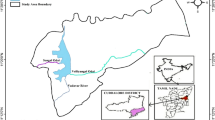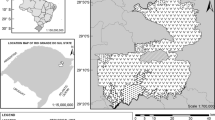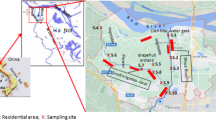Abstract
Oxygen (\({\updelta }^{18}\hbox {O}\)) and hydrogen (\({\updelta }^{2}\hbox {H}\) and \(^{3}\hbox {H}\)) isotopes of water, along with their hydrochemistry, were used to identify the source of a newly emerged seepage water in the downstream of Lake Nainital, located in the Lesser Himalayan region of Uttarakhand, India. A total of 57 samples of water from 19 different sites, in and around the seepage site, were collected. Samples were analysed for chemical tracers like \(\hbox {Ca}^{++}\), \(\hbox {Mg}^{++}\), \(\hbox {Na}^{+}\), \(\hbox {K}^{+}\), \({\hbox {SO}_{4}}^{--}\) and \(\hbox {Cl}^{-}\) using an Ion Chromatograph (Dionex IC-5000). A Dual Inlet Isotope Ratio Mass Spectrometer (DIIRMS) and an Ultra-Low Level Liquid Scintillation Counter (ULLSC), were used in measurements of stable isotopes (\({\updelta }^{2}\hbox {H}\) and \({\updelta }^{18}\hbox {O}\)) and a radioisotope (\(^{3}\hbox {H}\)), respectively. Results obtained in this study repudiate the possibility of any likely connection between seepage water and the lake water, and indicate that the source of seepage water is mainly due to locally recharged groundwater. The study suggests that environmental isotopes (\({\updelta }^{2}\hbox {H}\), \({\updelta }^{18}\hbox {O}\) and \(^{3}\hbox {H}\)) can effectively be used as ‘tracers’ in the detection of the source of seepage water in conjunction with other hydrochemical tracers, and can help in water resource management and planning.






Similar content being viewed by others
References
Adomako D, Gibrilla A, Maloszewski P, Ganyaglo S Y and Rai S P 2015 Tracing stable isotopes (\({\updelta }^{2}\text{H}\) and \({\updelta }^{18}\text{ O }\)) from meteoric water to groundwater in the Densu River basin of Ghana; Environ. Monit. Assess. https://doi.org/10.1007/s10661-015-4498-2.
Ahmed N, Wallin B G and Majumder R K 2006 Use of hydrochemistry and stable isotope techniques in investigating seepage/leakage in Gumti flood dyke, Comilla; J. Civil Eng. 34(2) 81–90.
Anbalagan R and Singh B 1996 Landslide hazard and risk assessment mapping of mountainous terrains – a case study from Kumaun Himalaya, India; Eng. Geol. 43(4) 237–246.
Appelo C A 1988 Hydrochemistry for Hydrogeologists: Application of Chemical Theory; Institute for Earth Sciences, VU Amsterdam.
Ashraf Z 1978 A geological report on the drilling explorations carried out for the study of Nainital hill slope stability, Nainital District, Uttar Pradesh; Unpublished Report, Geological Survey of India, EGD (E), Lucknow.
Bartarya S K and Valdiya K S 1989 Landslides and erosion in the catchment of the Gaula River, Kumaun Lesser Himalaya, India; Mt. Res. Dev. 9(4) 405–419, https://doi.org/10.2307/3673588.
Bouchez C, Goncalves J, Deschamps P, Vallet-Coulomb C, Hamelin B, Doumnang J C and Sylvestre F 2016 Hydrological, chemical, and isotopic budgets of Lake Chad: A quantitative assessment of evaporation, transpiration and infiltration fluxes; Hydrol. Earth Syst. Sci. 20(4) 1599–1619, https://doi.org/10.5194/hess-20-1599-2016.
Brenninkmeijer C A and Morrison P D 1987 An automated system for isotopic equilibration of \(\text{ CO }_{2}\) and \(\text{ H }_{2}\text{ O }\) for \(^{18}\text{ O }\) analysis of water; Chem. Geol. (Isot. Geosci. Sect.) 6(1) 21–26.
Chen J and Dong H 2001 Study of fissured-rock seepage flow with isotope tracer method in single borehole; Sci. China Ser. E-Tech. Sci. 44(1) 108–113, https://doi.org/10.1007/BF02916799.
Choudhary P, Routh J, Chakrapani G J and Kumar B 2009 Biogeochemical records of paleoenvironmental changes in Nainital Lake, Kumaun Himalayas, India; J. Paleolimnol. 42(4) 571–586, https://doi.org/10.1007/s10933-009-9306-y.
Clark I D and Fritz P 1997 Environmental isotopes in hydrogeology; CRC press.
Coulson A L 1939 Geological report on the alignment of the power pipeline of the Nainital Municipal Board’s hydroelectric scheme, Unpublished Report, Geological Survey of India, Lucknow.
Craig H 1961 Isotopic variations in meteoric waters; Science 133(3465) 1702–1703, https://doi.org/10.1126/science.133.3465.1702.
Dansgaard W 1964 Stable isotopes in precipitation; Tellus 16(4) 436–468.
Deodhar A S, Ansari M A, Sharma S, Jacob N, Kumar U S and Singh G 2014 Isotope techniques for water resources management; BARC News Lett. 337 29–35.
Deshpande R D, Bhattacharya S K, Jani R A and Gupta S K 2003 Distribution of oxygen and hydrogen isotopes in shallow groundwaters from southern India: Influence of a dual monsoon system; J. Hydrol. 271(1) 226–239, https://doi.org/10.1016/S0022-1694(02)00354-2.
Dincer T, Payne B R, Florkowski T, Martinec J and Tongiorgi E G 1970 Snowmelt runoff from measurements of tritium and oxygen-18; Water Resour. Res. 6(1) 110–124, https://doi.org/10.1029/WR006i001p00110.
Drever J I 1988 The geochemistry of natural waters, Englewood Cliffs: Prentice Hall.
Epstein S and Mayeda T K 1953 Variations of the \(^{18}\text{ O }/^{16}\text{ O }\) ratio in natural waters; Geochim. Cosmochim. Acta 5 213–224, https://doi.org/10.1016/0016-7037(53)90051-9.
Froehlich K, Gibson J J and Aggarwal P 2002 Deuterium excess in precipitation and its climatological significance; International Atomic Energy Agency (IAEA); 2002, Report No. IAEA-CSP–13/P.
Gat J R, Bowser C J and Kendall C 1994 The contribution of evaporation from the Great Lakes to the continental atmosphere: Estimate based on stable isotope data; Geophys. Res. Lett. 21(7) 557–560.
Hashimi N H, Pathak M C, Jauhari P, Nair R R, Sharma A K, Bhakuni D S, Bisht M K and Valdiya K S 1983 Bathymetric study of the neotectonic Naini Lake in outer Kumaun Himalaya; Geol. Soc. India 41 91–104.
Johansson S and Dahlin T 1996 Seepage monitoring in an earth embankment dam by repeated resistivity measurements; European J. Eng. Environ. Geophys. 1 229–247.
Karanth K R 1987 Groundwater Assessment, Development and Management, Tata McGraw Hill, New Delhi, India.
Krabbenhoft D P, Bowser C J, Anderson M P and Valley J W 1990 Estimating groundwater exchange with lakes: 1. The stable isotope mass balance method; Water Resour. Res. 26(10) 2445–2453, https://doi.org/10.1029/WR026i010p02445.
Kumar B, Nachiappan R, Rai S P, Saravana Kumar U and Navada S V 1999 Improved prediction of life expectancy for a Himalyan Lake: Nainital Lake, UP, India; Mt. Res. Dev. 19(2) 113–121.
Kumar B, Rai S P, Kumar U S, Verma S K, Garg P, Kumar S V, Jaiswal R, Purendra B K, Kumar S R and Pande N G 2010 Isotopic characteristics of Indian precipitation; Water Resour. Res. 46(12) W12548, https://doi.org/10.1029/2009WR008532.
LaBaugh J W, Winter T C, Rosenberry D O, Schuster P F, Reddy M M and Aiken G R 1997 Hydrological and chemical estimates of the water balance of a closed-basin lake in north central Minnesota; Water Resour. Res. 33(12) 2799–2812, https://doi.org/10.1029/97WR02427.
Li F, Song X, Tang C, Liu C, Yu J and Zhang W 2007 Tracing infiltration and recharge using stable isotope in Taihang Mt., North China; Environ. Geol. l53(3) 687–696, https://doi.org/10.1007/s00254-007-0683-0.
Middlemiss C S 1890 Geological sketch of Nainital with some reference on the natural conditions governing mountain slopes; Rec. Geol. Surv. India 21(4) 213–234.
Nachiappan R P, Kumar B and Manickavasagam R M 2002 Estimation of subsurface components in the water balance of Lake Nainital (Kumaun Himalaya, India) using environmental isotopes; Hydrolog. Sci. J. 47(S1) S41–S54.
Payne B R 1983 Interaction of surface water with groundwater; In: Guidebook on Nuclear Techniques in Hydrology, Technical Reports Series. No. 91, International Atomic Energy Agency: Vienna, Austria, pp. 319–324.
Purushothaman P, Mishra S, Das A and Chakrapani G J 2012 Sediment and hydro biogeochemistry of Lake Nainital, Kumaun Himalaya, India; Environ. Earth Sci. 65(3) 775–788.
Rai S P, Kumar B, Kumar S, Garg P and Rawat Y S 2012 Identification of source of leakage in drainage gallery of Tehri dam using isotopic techniques; Hydrol. J. 35(3–4) 63–75.
Rawat J S 1987 Morphology and morphometry of the Naini lake, Kumaun, Lesser Himalaya; Geol. Soc. India 30(6) 493–498.
Rozanski K, Araguás-Araguás L and Gonfiantini R 1993 Isotopic patterns in modern global precipitation; Climate Change in Continental Isotopic Records 1–36, https://doi.org/10.1029/GM078p0001.
Saini R K, Swain S, Patra A, Khanday G J, Gupta H, Purushothaman P and Chakrapani G J 2008 Water chemistry of three Himalayan Lakes: Dal (Jammu & Kashmir), Khajjiar (Himachal Pradesh) and Nainital (Uttarakhand); Him. Geol. 29(1) 63–72.
Saravana Kumar U, Jacob N, Navada S V, Rao S M, Nachiappan R P, Kumar B and Murthy J S 2001 Environmental isotope study on hydrodynamics of lake Naini, Uttar Pradesh, India; Hydrol. Process. 15(3) 425–439, https://doi.org/10.1002/hyp.158.
Saravana Kumar U, Sharma S and Navada S V 2008 Recent studies on surface water–groundwater relationships at hydro-projects in India using environmental isotopes; Hydrol. Process. 22(23) 4543–4553, https://doi.org/10.1002/hyp.7058.
Saravana Kumar U, Sharma S, Navada S V and Deodhar A S 2009 Environmental isotopes investigation on recharge processes and hydrodynamics of the coastal sedimentary aquifers of Tiruvadanai, Tamilnadu State, India; J. Hydrol. 364(1) 23–39, https://doi.org/10.1016/j.jhydrol.2008.10.004.
Singh D, Rai S P, Kumar B, Jain S K and Kumar S 2016 Study of hydro-chemical characteristics of Lake Nainital in response of human interventions, and impact of \(20{\text{ th }}\) century climate change; Environ. Earth Sci. 75(20) 1380, https://doi.org/10.1007/s12665-016-6177-1.
Singh S P, Gopal B and Kathuria V 2001 Integrated management of water resources of Lake Nainital and its watershed: An environmental economics approach; EERC, Indira Gandhi Institute for Developmental Research, Mumbai.
Song X, Liu X, Xia J, Yu J and Tang C 2006 A study of interaction between surface water and groundwater using environmental isotope in Huaisha River basin; Sci. China Ser. D 49(12) 1299–1310, https://doi.org/10.1007/s11430-006-1299-z.
Stewart M K and Morgenstern U 2016 Importance of tritium-based transit times in hydrological systems; Wiley Interdisciplinary Reviews: Water 3(2) 145–154, https://doi.org/10.1002/wat2.1134.
Valdiya K S 1988 Geology and natural environment of Nainital hills, Kumaun Himalaya; Gyānodaya Prakāshan.
Yao T D, Sun W Z, Pu J C, Tian L D and Jiao K Q 2000 Characteristics of stable isotope in precipitation in the inland area: A case study of the relation between \(\delta ^{18}\text{ O }\) in precipitation and temperature in Urumqi River, China; J. Glaciol. Geocryo. l22(1) 15–22.
Yao Z, Liu J, Huang H Q, Song X, Dong X and Liu X 2009 Characteristics of isotope in precipitation, river water and lake water in the Manasarovar basin of Qinghai–Tibet Plateau; Environ. Geol. 57(3) 551–556, https://doi.org/10.1007/s00254-008-1324-y.
Acknowledgements
The authors are grateful to Uttarakhand State Council for Science & Technology (UCOST) for funding the project entitled ‘Identification of Source of Seepage/Leakage around Lake Nainital, District Nainital, Uttarakhand’. The authors express their sincere gratitude to Dr R Dobhal, D.G., UCOST, Dehradun, Mr. Dinesh Chand Tamta (Executive Engineer), Mr. Hemchand Joshi (Assistant Engineer) and Mr. Pankaj Dhoundhiyal (Junior Engineer) of Irrigation Division, Nainital for their generous support in conducting the field survey. We are also thankful to Director, National Institute of Hydrology, Roorkee for providing all administrative and financial support for the successful completion of the study. We also extend our gratitude to the anonymous reviewers for their precious comments and suggestions which helped in improving the manuscript.
Author information
Authors and Affiliations
Corresponding author
Additional information
Corresponding editor: N V Chalapathi Rao
Rights and permissions
About this article
Cite this article
Rai, S.P., Singh, D., Rai, A.K. et al. Application of environmental isotopes and hydrochemistry in the identification of source of seepage and likely connection with lake water in Lesser Himalaya, Uttarakhand, India. J Earth Syst Sci 126, 118 (2017). https://doi.org/10.1007/s12040-017-0889-9
Received:
Revised:
Accepted:
Published:
DOI: https://doi.org/10.1007/s12040-017-0889-9




